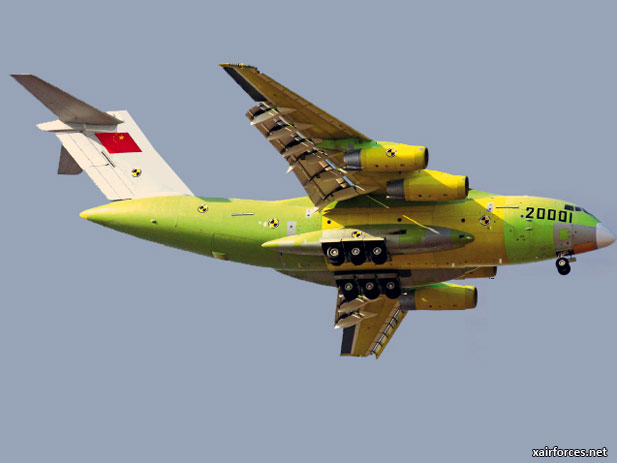
China's Xian Y-20 Airborne

January appears to have become a highly gifted month for the Chinese aerospace industry. To redux, on January 11, 2007, China knocked out one of its own ageing weather satellites, orbiting more than 800 km above the earth’s surface...
To redux, on January 11, 2007, China knocked out one of its own ageing weather satellites, orbiting more than 800 km above the earth’s surface, scoring a direct hit by an interceptor missile, destroying the satellite through kinetic energy alone, sending shockwaves in the global strategic community.
Four years later, on January 11, 2011, China once again stunned the world by launching its own home-grown 5th generation stealth jet fighter J-20 on its maiden test flight, timing the launch intentionally (or otherwise) with the visit of the US Defence Secretary to Beijing. China continued to spring surprises on the world in 2012 too, first, by launching another stealth fighter J-31 on November 1and then followed it up with J-15 naval fighter carrying out live test flights from the flight-deck of ‘Liaoning’ (its first aircraft carrier).
But, it reserved the month of January 2013 to once again shock the world by launching its heaviest military transport aircraft Y-20 on its maiden test flight – this time on January 26, even before the might of the Indian military could begin to be showcased down Rajpath to celebrate India’s 64th ‘Republic Day’.
Escorted by a J-15 fighter and numbered ‘20001’, the Y-20 successfully completed its first flight, remaining airborne for an hour.
The Y-20’s first flight suggests that China may be well on its way to joining the US and Russia as the third nation to independently develop and fly a heavy military jet transport aircraft.
With a 15-meter height, 47-meter fuselage length and a reported 66-tonne maximum load capacity, the aircraft claims to be in the same class as the US C-17 Globemaster III and Russia’s Il-76. In fact, some Chinese military aviation experts believe that the Y-20 outperforms the IL-76. Its capacious cargo hold can “carry a vast majority of combat and support vehicles of the Chinese People’s Liberation Army (PLA)”, including the PLA’s heaviest tank, the 58-tonne Type-99A2. It can transport them even to underdeveloped “airstrips” owing to its short take-off/ landing capabilities and ability to operate in rough field conditions. (See the accompanying comparison table).
Chinese claim the Y-20 to be a 100% indigenous design clearly different from other heavy transport aircraft such as the Russian IL-76, USA’s C-5 and C-17, and Europe’s A400M turboprop in fuselage shape, wheels and flap actuators. A close scrutiny of the attached photograph makes the Y-20 look like a hybrid cross between a C-17 and an IL-76. Chinese are known for reverse engineering/cloning and adapting ‘borrowed designs’ to their advantage and, contrary to the claims of its designers, Y-20 does not appear to be an ‘Exception’.
But that does not take away the glory of China once again achieving a fantastic milestone in its galloping aerospace industry. Y-20’s development would represent another meaningful step toward China being able to create more robust capability to project its aerospace power.
Y-20 offers a big platform to be used not only as a strategic airlifter but also in other force-multiplier roles such as for air refuelling (FRA) or for airborne early warning and control systems (AWACS). Eventually, it could also be exported if it could be built and sold for less than the cost of its competitors such as the Russian IL-76.
There is however a catch though in terms of availability of suitable engines to power the aircraft. The prototype which flew on January 26 is powered by four Solviev D-30KP-2 engines. China plans to use its own under-development WS-20 engines for production aircraft. But, jet engines have so far proved to be the ‘Achilles heel’ for the Chinese aerospace industry. Most of their aircraft are powered by imported engines (mostly from Russia) or their clones.
Although not to the same extent, China’s jet propulsion programmes are inflicted with debilitating problems somewhat similar to what India is experiencing in developing the ‘Kaveri’ jet engine for its indigenous LCA ‘Tejas’ fighter aircraft.
Possible delays in the development of the WS-20 engine could also result in slowing down the Y-20 programme which, otherwise, is slated to start production for operational deployment of the aircraft in China’s PLAAF (People’s Liberation army air Force) by 2017-18.
Source: By Our Technology Correspondent, India Strategic News – 2 March 2013
Photo: The China Air Force Xian Y-20 Airborne (Photo by indiastrategic.in)
(2.03.2013)
|